ALUMINUM
Properties of Aluminum
One of the reasons aluminum cookware is so popular
is that it is an excellent conductor of heat. Because of this quality, heat spreads quickly and evenly across the bottom, up the sides and across the cover to completely surround the food being cooked. Aluminum frying pans are particularly popular with consumers in that they help sauté and fry foods quickly. Aluminum is a lightweight metal, about one-third the weight of steel, so in the kitchen, it means that a sturdy aluminum pan is also easy to handle. Aluminum is used for both top of stove cookware and bakeware. Aluminum also does not rust.
Aluminum is also the third most abundant element in the earth’s crust. In nature, aluminum is always found in combination with other materials. An ore called bauxite is our most common source of the metal. Bauxite contains a greater percentage of aluminum than do other ores, and the metal can be extracted more economically. Manufacturing Processes
Aluminum cookware is manufactured principally by the following methods: stamping, drawing and casting. Stamping or Drawing: In the stamping or drawing method, flat sheets or circles rolled to the desired thickness are placed on a press. The press then forms the sheet metal into the desired shape. Afterward, both inside and outside finishes are applied, and appropriate handles and knobs are attached.
Casting: Molten aluminum is poured into molds specially designed for each different cookware utensil. These molds allow the thickness of the cookware to be strategically varied in different areas of the pan for maximum cooking efficiency. For instance, the pan bottoms can be made extra thick for superior heat absorption and the pan walls can be slightly tapered to help create circular heat movement up and down the pan. When the aluminum cools, the mold is opened and the cookware is removed. Cast aluminum utensils are often heavier and thicker than stamped utensils. The bodies of all aluminum utensils are made in one piece so that there are no seams or hard-to-clean crevices.
Generally the gauge or thickness of the aluminum utensils is one feature that determines its quality. The heavier the gauge (thickness), the more durable—and more costly—the utensil. For this reason, the intended use of the utensil should be considered when purchasing. Gauge is usually described by a number, the smaller the number the thicker the aluminum. For example, eight (8) gauge aluminum is thick (.125 inch); twenty (20) gauge aluminum is thin (.032 inch).
Finishes
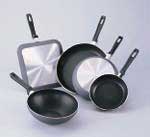 Aluminum utensils are manufactured with a wide variety of finishes. Stamped and drawn utensils may have exterior finishes of polished natural aluminum, chrome plate, anodized (with or without color), porcelain enamel coatings, nonstick coatings or colored organic coatings (acrylics, polyamides, etc.). Usually bottoms have a satin finish or are porcelain enamel coated; both finishes help absorb heat. Cast aluminum utensils may have exterior finishes of colored porcelain enamel coating, polished, hammered or velva-glazed natural surfaces, colored organic coating, or hard-coat anodized surfaces. Aluminum utensils are manufactured with a wide variety of finishes. Stamped and drawn utensils may have exterior finishes of polished natural aluminum, chrome plate, anodized (with or without color), porcelain enamel coatings, nonstick coatings or colored organic coatings (acrylics, polyamides, etc.). Usually bottoms have a satin finish or are porcelain enamel coated; both finishes help absorb heat. Cast aluminum utensils may have exterior finishes of colored porcelain enamel coating, polished, hammered or velva-glazed natural surfaces, colored organic coating, or hard-coat anodized surfaces.
The inside finish on aluminum utensils may be a natural finish, “sunray” or “spun” finish, high polish finish, hard-coat anodized finish or nonstick coating.
A majority of aluminum cookware is non-stick coated. You can learn more about these interior finishes
later in this course.
Use and Care
New aluminum utensils require washing in warm sudsy water to remove any residual manufacturing oils.
After use aluminum utensils, like most cookware, should be allowed to cool before washing or soaking. This is a simple safeguard against warping, as well as preventing accidental burns in handling. Drying immediately after washing will help preserve their appearance. Utensils should be washed each time they are used.
Undissolved salt allowed to remain on an aluminum surface may cause pitting. Consumers should add salt to liquid after it reaches the boiling point and stir to dissolve it completely. Acid or salty foods should not remain in aluminum or aluminum-finished utensils for long periods of time, because this may cause pitting.
Because it combines easily with other natural elements, aluminum may stain when it contacts minerals in water and foods. Automatic dishwashing may increase the amount of staining when the high heat of the drying cycle is added to minerals naturally present in water and the chemicals used to purify water. For that reason, hand washing may be preferred to preserve the attractive finish of aluminum utensils.
Utensils with coated exteriors and interiors may be washed in automatic dishwashers. However, care should be taken when loading them into the dishwasher to avoid marring or scratching the coating.
Stains and discoloration that may appear on aluminum utensils can be removed by boiling a solution of two to three tablespoons of cream of tartar, lemon juice or vinegar to each quart of water in the utensil for five to ten minutes. Then lightly scour with a soap-filled scouring pad. Cooking acidic foods such as tomatoes or rhubarb will remove the stains naturally without affecting the cooked food product. To remove stains from the aluminum exterior, use a nonabrasive cleanser.
Cooking tools made of wood, plastic, or smooth edged metal are recommended for use in aluminum utensils, particularly those with non-stick interiors. Sharp-edged tools such as knives, masher and beaters may scratch aluminum. Check the manufacturer’s recommendation.
STAINLESS STEEL
Properties of Stainless Steel
Stainless steel cookware and bakeware is exceptionally durable. Once stainless steel has been stamped, spun or formed into utensil shape, it takes an extremely hard blow to dent it. Its attractive finish won’t corrode or tarnish permanently, and its hard, tough, nonporous surface is resistant to wear. Extremely smooth and scratch resistant, stainless steel utensils take an excellent polish.
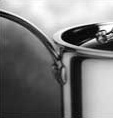 Top-of-the-range cookware, bakeware, pantryware, tools and other equipment are frequently produced in stainless steel, which eases the work of homemakers. Top-of-the-range cookware, bakeware, pantryware, tools and other equipment are frequently produced in stainless steel, which eases the work of homemakers.
Like other steels, stainless steel is an alloy—a combination of iron and other metals. What makes it different from other steels, however, is that it contains at least 11 percent chromium. It is chromium that makes steel “stainless” all the way through.
Stainless steel may also contain other elements, such as nickel, molybdenum, columbium or titanium. These materials can contribute special hardness, high temperature resistance, and resistance to scratching and corrosion to the finished stainless steel alloy.
Sometimes you’ll hear a shorthand way of describing stainless steel, such as “18/10” or “18/8”. The first figure indicates the percentage of chromium contained within the stainless. The second number is the percentage of nickel. Nickel is an alloying element used in steel to increase its ductility, or its ability to be formed. Both of these elements are very expensive compared to regular steel, hence the higher costs of stainless steel.
Manufacturing
Stainless steel bakeware utensils are usually fabricated of solid stainless steel. On the other hand, top-of-range stainless steel utensils are generally made by combining stainless with other metals, usually aluminum, copper or carbon steel. The other metals improve the utensil’s heat conductivity. Various manufacturing processes are used to combine stainless steel with these other metals. The resulting combinations are described as two-ply, three ply, threeply/ bottom clad, five/ply bottom clad and five-ply, seven-ply and even nine-ply, depending on the manufacturer and the desired characteristics of the cookware.
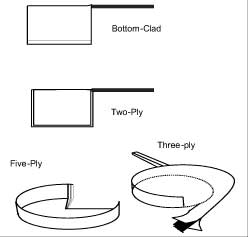
Two-ply utensils commonly have a stainless steel interior with another metal on the exterior. In a few instances, this arrangement is reversed with the stainless steel on the outside and a non-stick surface applied to the interior.
Three-ply utensils have stainless steel on both the inside and outside surfaces with a layer of copper, carbon steel or aluminum forming the core.
Bottom clad utensils are formed with solid stainless or three-ply, and copper is plated to the bottom or aluminum is applied to the bottom by casting, bonding or metal spraying. Five-ply/bottom clad utensils are made by the three-ply process, with two clad layers on the bottom. Five-ply utensils are made with stainless steel on both the inside and outside surfaces with three layers of aluminum or other metals forming the core. In the actual manufacture of stainless steel utensils, the metal’s versatility permits it to be formed into a wide variety of attractive and functional shapes, limited only by the imagination of the designer or the desires of the consumer.
Finishes
Appearance is an important consideration in the selection of cooking utensils. A choice of high polish or satin finish is normally available on stainless steel ware. Either of these attractive finishes blends well with all colors and periods of kitchen décor. Also, to meet decorator demand for color in cookware, manufacturers are producing cookware with porcelain enamel exteriors on stainless steel. But the cooking surface is most often stainless steel, where ease of cleaning and protection of food quality are most important. There are some stainless steel utensils with nonstick interiors. The preparation of stainless steel for nonstick finishes is a complicated process, due to the hardness of the steel and its very smooth finish. Additionally, it takes more time and energy to cure the nonstick finish in stainless steel due to its less-conductive nature.
Use and care
Before using a new stainless steel utensil, wash the utensil thoroughly in hot sudsy water to remove any manufacturing oils and polishing compounds. Stainless steel is one of the easiest materials to clean and to keep clean. Washing by hand in hot sudsy water or in a dishwasher usually is the only requirement for keeping stainless utensils bright and shiny. Prompt drying will prevent water spots.
To remove burned-on foods, soak and wash in hot sudsy water. Light scouring with a non-abrasive household cleaner and a nylon scouring pad or a commercial stainless steel cleaner will removed stubborn burns on the interior surfaces. High heat may cause a mottled, rainbow-like discoloration commonly called
“heat tint”. Cooking certain starchy foods–such as
rice, potatoes or peas–may cause a stain on the inside
of the pan. Both of these can be removed easily with
any one of a number of readily available stainless
steel cleaners. Undissolved salt will “pit” steel surfaces.
Consumers should add salt to liquid after it
reaches the boiling point and stir to dissolve completely.
Do not allow acid or salty foods to remain in
stainless steel for long periods of time.
With normal use, a stainless steel utensil will not dent, warp or chip. It thrives on exposure to air, so it is an attractive utensil to display in the kitchen.
PORCELAIN ON STEEL and CAST IRON
Porcelain enamel has served the needs of mankind for centuries. The exact time and place of its origin are not know, but museums throughout the world contain many examples that are older than two thousand years. These ancient artifacts remain as bright, clean and well defined as the day they were created.
Originally porcelain enamel was an artistic medium for making fine jewelry and, even when it was used to make a functional object such as an urn or small box, it was invariably fashioned in painstaking, handcrafted designs. For centuries porcelain enameling developed as an art form, with only gold, silver, copper and bronze used as its base metal.
Then, in 1830, a Bohemian craftsman found he could create a permanent, smooth, glassy surface on cast iron by dusting the red-hot metal with dry, powdered porcelain---and a new era dawned. From that time on, porcelain enamel became a utilitarian as well as a decorative finish.
Porcelain enamel is essentially a highly durable glass which, with coloring oxides and other inorganic materials, is fused to metal at extremely high temperatures. It first found its way into the kitchen as a decorative finish for wood-burning ranges and cast iron utensils. Later, when techniques were discovered for applying it to sheet steel, it became a standard coating for coffeepots, roasting pans and saucepans.
Manufacturing
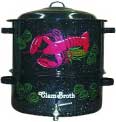 In the manufacture of cooking utensils, porcelain enamel is applied after the the metal is formed into its final shape. While porcelain can be applied to aluminum, and stainless steel, the most common substrate is steel followed by cast iron. It is one of the most versatile finishes, offering virtually an unlimited range of colors and design effects. Today’s colors included many shades of reds, greens, blues, yellows and oranges in addition to the traditional “speckled” pattern. There are also decorative porcelain decals, mechanically applied that have the same scratch and stain resistant qualities of the regular porcelain coating. In the manufacture of cooking utensils, porcelain enamel is applied after the the metal is formed into its final shape. While porcelain can be applied to aluminum, and stainless steel, the most common substrate is steel followed by cast iron. It is one of the most versatile finishes, offering virtually an unlimited range of colors and design effects. Today’s colors included many shades of reds, greens, blues, yellows and oranges in addition to the traditional “speckled” pattern. There are also decorative porcelain decals, mechanically applied that have the same scratch and stain resistant qualities of the regular porcelain coating.
Use and care
Aside from the variety of colors and designs available, the chief recommendations for porcelain enamel are its stain and scratch resistance, its immunity to fading and peeling, its chemical resistance, and the fact that it will not pick up food odors. Porcelain enamel utensils can be used for cooking, baking, serving and storing food. Do not use porcelain enamel utensils over high heat for a prolonged time; extreme high temperatures may cause the porcelain to melt. Additionally, consumers should be careful in using porcelain on metal pans on ceramic or glass cooktop surfaces. Should the pan boil dry the glass coating can adhere to the cooktop, resulting in a crack when the pan is removed.
Cleaning porcelain enamel is easy: just wash in warm sudsy water, using a sponge or cloth. Burned on foods or other stubborn stains can be removed by soaking or by using a non-abrasive cleanser and a nylon or other non-abrasive scrubber. All porcelain
enamel utensils are safe in modern dishwashers
CAST IRON
Properties of cast iron
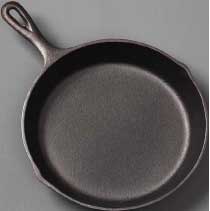 The most important properties of cast iron are its heat retention and heat distribution. It is also extremely durable. Properly cared for, cast iron will last for g e n e r a t i o n s . Considered by professional chefs to be precision cooking tools, quality cast iron utensils enable precise control of cooking temperatures. Its heat retention qualities allow for even cooking
temperatures without hot spots. The most important properties of cast iron are its heat retention and heat distribution. It is also extremely durable. Properly cared for, cast iron will last for g e n e r a t i o n s . Considered by professional chefs to be precision cooking tools, quality cast iron utensils enable precise control of cooking temperatures. Its heat retention qualities allow for even cooking
temperatures without hot spots.
Cast iron cookware isn’t pure iron. Other materials, such as carbon and phosphorus, are mixed with the iron to produce proper hardness and durability. Iron with impurities included in it can heat unevenly and crack. Evidence of poor metal mixes include discoloration of the cast iron, striations or smooth bright
spots of “white metal”.
Cast iron is currently used for utensils that include skillets, roasters and Dutch ovens, broilers, griddles and some specialty items, such as muffin and corn bread pans. These utensils are excellent for browning,
frying, stewing and baking foods.
Manufacturing
Cast iron cookware is produced in a sand-cast process. Quality cast iron requires sand molds made under high pressure so that their shapes can be precisely controlled. In addition to careful attention to the metal used in cast iron, the manufacturer must also control the components of the sand, which include clay, and water. Patterns are pressed into the sand and the molten iron is poured in to the resulting cavity. As the iron cools to its solid state and becomes a cooking utensil, the sand mold is broken apart. The sand is cleaned off the utensil. It is then smoothed and packed
for shipment.
Use and care
Natural cast iron utensils should be seasoned before using. After washing the utensil with warm water, dry with a towel and apply a thin coat of vegetable oil and place in a 350ºF oven for about an hour and let cool. Over time, the utensil will darken to a black patina, a lasting, nonstick finish. Some cast iron is available now in the market that has a true seasoned finish installed at the factory. Buyers should recognize that what some manufacturers claim as a preseasoning is nothing more than wax coating designed to keep the product from rusting before sale. At least once manufacturer has perfected a preseasoning that results in a
“ready to cook” surface similar to that done by the
consumer.
Natural cast iron utensils should never be stored with the cover on, as this might cause “sweating” and consequent rust damage. Store these utensils in a dry place.
Cast iron utensils with porcelain enamel interiors do not need seasoning. Hot sudsy water and thorough rinsing will keep them clean and shining.
TINPLATE
The genealogy of tinplate in the kitchen can be traced to ancient times. Tin was widely used in Egypt, although it was not found there. Daring Phoenician sailors ventured to the British Isles, then known as the Cassiterides or Isles of Tin, to obtain this precious metal. Tin plating— the process of plunging plates of iron into molten tin—was discovered in Germany during the 16th century. The secret of using tin as a protective coating for metal was brought to England about 1670.
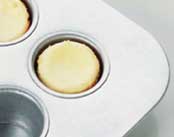 In our age of new concepts in materials and fabricating methods, tin-plate steel still plays a fairly minor role in the baking industry. Many commercial baking utensils are made from tin-plated steel because it is durable and possesses excellent baking qualities. The consumer market for this type of merchandise has also somewhat less important over the years with the introduction of coated carbon steel bakeware. In our age of new concepts in materials and fabricating methods, tin-plate steel still plays a fairly minor role in the baking industry. Many commercial baking utensils are made from tin-plated steel because it is durable and possesses excellent baking qualities. The consumer market for this type of merchandise has also somewhat less important over the years with the introduction of coated carbon steel bakeware.
Very little care is required in using tin-plate bakeware. This steel-based material is highly resistant to denting and scratching. Tinplate provides the necessary protection that helps the steel resist rusting and staining, all though in humid climates the underlying steel can rust if the coating cracks or is otherwise distupted. Alight application of oil or grease will prevent this.
GLASS, CERAMIC AND GLASS-CERAMIC
In the twentieth century, heat-resistant glass and glass-ceramic materials were developed. Like ceramic materials, they meet the need for attractive ware used for mixing, cooking, serving and storing. Major features are attractiveness, one-dish convenience, and inert, non-porous surfaces that won’t absorb food odors and flavors.
While most are very rugged, they can break under impact. However, some glass, ceramic and glassceramic cookware manufacturers warranty their products against thermal breakage, and offer free replacement should the ware break in normal use within the warranty conditions.
 Heat-resistant glass cookware may be made of clear or tinted t r a n s p a r e n t material or opaque white ( c o m m o n l y called “opal” glass). Glass-ceramic cookware may be white or transparent and tinted. Ceramic cookware is available in white or a variety of colors. Heat-resistant glass cookware may be made of clear or tinted t r a n s p a r e n t material or opaque white ( c o m m o n l y called “opal” glass). Glass-ceramic cookware may be white or transparent and tinted. Ceramic cookware is available in white or a variety of colors.
Properties of glass, ceramic and glass-ceramic
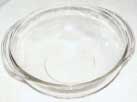 Heat-resistant glass can be used for storing, cooking and serving. Some pieces can be used on the rangetop, while others are suitable only for the oven. Those designed for baking can be taken from the refrigerator and put into preheated ovens after the utensil reaches room temperature. As a rule, they should not be used on the stove top or under the broiler. Heat-resistant glass stove top products should usually be used with a wire grid on an electric range but should never be taken from the refrigerator or freezer and placed directly on a hot stove’s element. Similarly, sudden cooling may be harmful to glass cookware. Hot glass cookware should not be allowed to come into contact with wet countertops, nor should they be placed in water while they are still hot. Heat-resistant glass can be used for storing, cooking and serving. Some pieces can be used on the rangetop, while others are suitable only for the oven. Those designed for baking can be taken from the refrigerator and put into preheated ovens after the utensil reaches room temperature. As a rule, they should not be used on the stove top or under the broiler. Heat-resistant glass stove top products should usually be used with a wire grid on an electric range but should never be taken from the refrigerator or freezer and placed directly on a hot stove’s element. Similarly, sudden cooling may be harmful to glass cookware. Hot glass cookware should not be allowed to come into contact with wet countertops, nor should they be placed in water while they are still hot.
Some ceramic cookware is made of heat-resistant materials that can go from the freezer to a hot oven or microwave. None is suitable for top-of-range or broiler use. Like glass cookware, ceramic cookware holds heat for a long time while providing the additional benefit or an attractive serving dish. Ceramic cookware is available in a wide variety of shapes, colors and designs.
Among the most thermally shock-resistant materials ever developed by man, glass-ceramic is a true spaceage material. It was first used in rocket nosecones because the glass-ceramic material could take the extreme temperature changes encountered in their supersonic flight from the earth’s surface into outer space and back. Glass-ceramic cookware offers wide food preparation versatility. It can be used for stove top cooking and is excellent for roasting, broiling or baking---in the conventional or microwave oven. It can go directly from the freezer to the stove top, broiler or hot oven. Glass-ceramic cookware can be immersed, hot off the stove, into sudsy dishwater for easy cleanup.
Manufacturing
Glass is a non-crystalline material manufactured by melting a combination of raw materials including sand, soda ash, limestone, feldspar and borax. The glass used in cookware is normally melted in a large refractory furnace or tank at temperatures exceeding 2000° F. A small portion of the molten glass is drawn out of the tank and is blown or pressed into a mold. The mold essentially cools the glass, causing it to solidify. Following forming, the glass article is cooked to room temperature on a schedule specifically designed to insure the development of the desired heat-resistant characteristics.
Glass-ceramic is a special glass composition that is melted and formed like heat-resistant glass. Following forming, the articles are subjected to a special heat-treating schedule resulting in the development of a fine crystalline structure throughout the article. It is this crystalline structure (which may be transparent or opaque) that gives the glass-ceramic its unique performance characteristics.
Ceramic cookware is manufactured from a mixture of water, clays, fluxing minerals (often feldspar) and finely ground sand. The particular forming methods depends largely on the water content of the mixture. A high water content (relatively liquid solution) permits casting of the ware in a mold. Lower water content results in a plastic mass that can be forced into the desired shape by a variety of methods.
After forming, the ware is dried and fired (subjected to temperatures in excess of 2000° F) in a ceramic kiln to bond the components of the “body” together. Following this initial firing, the surface of the ware is coated with a glaze that, upon firing in a second ceramic kiln, develops a smooth nonporous surface much like glass. For glass and ceramic cookware with nonstick interiors three layers of nonstick coating are applied to specially prepared interior surfaces and then cured at approximately 800? F.
Use and care
Ceramic, glass and glass-ceramic materials are excellent retainers of heat. Baking dishes and casseroles made of these materials hold the food’s heat long after it is removed from the oven. It is usually recommended to use these items at slightly lower oven temperatures for a shorter length of time because the covered cookware continues to cook foods even after it’s been removed from the oven. A rule of thumb is to reduce the recommended oven temperature about 25 F (14 C).
Check the manufacturer’s recommended care and use instructions before using any glass, ceramic and glass-ceramic bakeware. These items are usually cleaned with hot sudsy water and soaked if food has been burned on the item. Avoid knives, sharp kitchen tools, scouring pads and abrasive cleaners so that surfaces retain their original smooth finish. This is especially important for ovenware with nonstick interiors. Nylon and plastic scrubbers are acceptable for stubborn sticking problems.
PLASTICS
Since the mid 1970’s, space-age technology has led to many new developments and improvements of plastic materials. Plastic materials now have significantly improved durability and heat resistance leading to their use by manufacturers for ovenware and bakeware.
Plastic ovenware includes a broad category of materials with widely different characteristics. Many shapes, sizes, colors and designs of plastic ovenware are available today. Some shapes are specifically designed for small, compact microwave ovens, while others are made to accommodate certain foods.
Properties
The family of materials used in plastic ovenware provides a number of unique features not necessarily found in the many plastic household items used for serving, storing or packaging. The plastic material used for plastic ovenware is one of three kinds: thermoset plastic, thermoplastic or silicone.
The thermoset plastic materials used for plastic ovenware have a high heat resistance, which make them suitable for use from the freezer to the microwave, convection or conventional oven. An example of a thermoset plastic material is fiberglass-reinforced polyester. This type of ovenware is rigid and consequently will retain the original ovenware share, with temperatures of 400°F/204°C.
 Thermoplastic materials for plastic ovenware can be taken from the freezer to the microwave oven to the table. The thermoplastic category includes a number of special compositions for ovenware, all of them considered lightweight and impact-resistant. Some commonly used thermoplastic ovenware materials include polymethylpentene (TPX), polycarbonate and polysulfone. Thermoplastic materials for plastic ovenware can be taken from the freezer to the microwave oven to the table. The thermoplastic category includes a number of special compositions for ovenware, all of them considered lightweight and impact-resistant. Some commonly used thermoplastic ovenware materials include polymethylpentene (TPX), polycarbonate and polysulfone.
Silicone is an especially high-heat resistance plastic that can be used for bakeware and is usually safe up to oven temperatures of 450 degrees. Silicone pans, unless wire reinforced, usually must be supported on an oven proof pan when placed in the oven.
All of the thermoset, thermoplastic and silicone ovenware products are dishwasher safe, stain-resistant, breakresistant and easy to clean. These unique characteristics have increased the popularity of plastic ovenware and continued to improve the acceptance of plastic for cooking.
Manufacturing
The thermoset plastics are compression molded by using a predetermined weight of material which is either formed or compressed into a slug or pill and is placed in the mold when the mold is in an open condition. The mold then closes and heat and pressure are applied to this plug which forces the resin into all areas of the cavity as it compresses the material.
The thermoplastic or injection molded materials are formed in an injection press in which the material passes through a heated barrel, reducing it to a liquid which is then forced under pressure into the mold itself. The mold is then cooled. Subsequently, the plastic is also cooled and solidified. The parts are then ejected from the mold. Silicone is molded in a similar fashion.
Use and care
Before using any plastic ovenware, check the manufacturer’s carton, labels and booklets for special instructions. Wash the utensils thoroughly in hot sudsy water before first use.
All plastic ovenware is easy to clean in the dishwasher or by hand washing. However, all ovenware requires extra cleaning effort if food is allowed to burn. In such cases soak the plastic ovenware in soap and water, then remove the food with a nylon or plastic scrubber. In order to avoid damage to the surface, do not use an abrasive cleaner, scouring pads, strong solvents or sharp kitchen tools.
New plastic ovenware with nonstick coatings can be used in conventional, convection and microwave ovens. Convenience and versatility are highlighted. The nonstick-coated ovenware goes safely from oven, to freezer, microwave and table.
STEEL
Carbon steel is used chiefly in the manufacture of bakeware. For top of stove use, carbon steel is typically found in imported woks and small frying pans. One of carbon steel’s most important qualities is its inexpensive price.
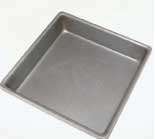 Carbon steel that is not covered with a factory coating or finish, must be seasoned with oil, just as raw cast iron is, in order to prevent rusting. Such oil seasonings cannot be cleaned in home dishwashers. Most carbon steel, if it is not coated, will have a black oxide finish. While this is attractive it doesn’t offer significant
resistance to rusting Carbon steel that is not covered with a factory coating or finish, must be seasoned with oil, just as raw cast iron is, in order to prevent rusting. Such oil seasonings cannot be cleaned in home dishwashers. Most carbon steel, if it is not coated, will have a black oxide finish. While this is attractive it doesn’t offer significant
resistance to rusting
On the other hand, carbon steel, coated with today’s high performance coatings, (so long as their integrity is not compromised) is widely used for bakeware. The dark coatings absorb oven energy well and allow for the use of lower baking temperatures and even baking results.
Carbon steel cookware and bakeware may be produced by stamping, drawing or by folding.
COPPER
Copper, alone or in an alloyed form, has been used in cooking utensils almost since the dawn of history. Copper’s uniform heat conductivity makes it a good material for top-of-range cooking because the heat is rapidly distributed evenly. This property also enables copper serving utensils to keep foods warm and palatable.
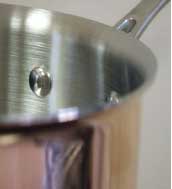 Copper cooking surfaces are usually lined with tin, stainless steel or coated with a nonstick finish because foods left directly in contact with uncoated copper may become discolored. The discoloration tends to detract from the food’s eye appeal. Additionally, raw copper pans should never be used to cook acidic foods since copper salts which are poisonous can be produced. Copper cooking surfaces are usually lined with tin, stainless steel or coated with a nonstick finish because foods left directly in contact with uncoated copper may become discolored. The discoloration tends to detract from the food’s eye appeal. Additionally, raw copper pans should never be used to cook acidic foods since copper salts which are poisonous can be produced.
An electrolytic process that deposits copper on the bottom of a stainless steel utensil utilizes copper’s superior heat distribution. Another manufacturing process bonds or laminates copper to stainless steel and other metals. A core of solid copper sandwiched between two layers of stainless steel is another way copper is used to distribute heat uniformly.
Use and care
Copper can be easily polished with various commercial copper cleaners. A mixture of flour, salt, lemon juice and ammonia or a mixture of vinegar and flour are two other methods of keeping copper utensils shiny. After cleaning, wash in sudsy water, and rinse before polishing with a soft, clean cloth.
Tin linings may wear off with frequent use; the utensil can be retinned.
| 
 Aluminum utensils are manufactured with a wide variety of finishes. Stamped and drawn utensils may have exterior finishes of polished natural aluminum, chrome plate, anodized (with or without color), porcelain enamel coatings, nonstick coatings or colored organic coatings (acrylics, polyamides, etc.). Usually bottoms have a satin finish or are porcelain enamel coated; both finishes help absorb heat. Cast aluminum utensils may have exterior finishes of colored porcelain enamel coating, polished, hammered or velva-glazed natural surfaces, colored organic coating, or hard-coat anodized surfaces.
Aluminum utensils are manufactured with a wide variety of finishes. Stamped and drawn utensils may have exterior finishes of polished natural aluminum, chrome plate, anodized (with or without color), porcelain enamel coatings, nonstick coatings or colored organic coatings (acrylics, polyamides, etc.). Usually bottoms have a satin finish or are porcelain enamel coated; both finishes help absorb heat. Cast aluminum utensils may have exterior finishes of colored porcelain enamel coating, polished, hammered or velva-glazed natural surfaces, colored organic coating, or hard-coat anodized surfaces. Top-of-the-range cookware, bakeware, pantryware, tools and other equipment are frequently produced in stainless steel, which eases the work of homemakers.
Top-of-the-range cookware, bakeware, pantryware, tools and other equipment are frequently produced in stainless steel, which eases the work of homemakers.
 In the manufacture of cooking utensils, porcelain enamel is applied after the the metal is formed into its final shape. While porcelain can be applied to aluminum, and stainless steel, the most common substrate is steel followed by cast iron. It is one of the most versatile finishes, offering virtually an unlimited range of colors and design effects. Today’s colors included many shades of reds, greens, blues, yellows and oranges in addition to the traditional “speckled” pattern. There are also decorative porcelain decals, mechanically applied that have the same scratch and stain resistant qualities of the regular porcelain coating.
In the manufacture of cooking utensils, porcelain enamel is applied after the the metal is formed into its final shape. While porcelain can be applied to aluminum, and stainless steel, the most common substrate is steel followed by cast iron. It is one of the most versatile finishes, offering virtually an unlimited range of colors and design effects. Today’s colors included many shades of reds, greens, blues, yellows and oranges in addition to the traditional “speckled” pattern. There are also decorative porcelain decals, mechanically applied that have the same scratch and stain resistant qualities of the regular porcelain coating. The most important properties of cast iron are its heat retention and heat distribution. It is also extremely durable. Properly cared for, cast iron will last for g e n e r a t i o n s . Considered by professional chefs to be precision cooking tools, quality cast iron utensils enable precise control of cooking temperatures. Its heat retention qualities allow for even cooking
temperatures without hot spots.
The most important properties of cast iron are its heat retention and heat distribution. It is also extremely durable. Properly cared for, cast iron will last for g e n e r a t i o n s . Considered by professional chefs to be precision cooking tools, quality cast iron utensils enable precise control of cooking temperatures. Its heat retention qualities allow for even cooking
temperatures without hot spots. In our age of new concepts in materials and fabricating methods, tin-plate steel still plays a fairly minor role in the baking industry. Many commercial baking utensils are made from tin-plated steel because it is durable and possesses excellent baking qualities. The consumer market for this type of merchandise has also somewhat less important over the years with the introduction of coated carbon steel bakeware.
In our age of new concepts in materials and fabricating methods, tin-plate steel still plays a fairly minor role in the baking industry. Many commercial baking utensils are made from tin-plated steel because it is durable and possesses excellent baking qualities. The consumer market for this type of merchandise has also somewhat less important over the years with the introduction of coated carbon steel bakeware. Heat-resistant glass cookware may be made of clear or tinted t r a n s p a r e n t material or opaque white ( c o m m o n l y called “opal” glass). Glass-ceramic cookware may be white or transparent and tinted. Ceramic cookware is available in white or a variety of colors.
Heat-resistant glass cookware may be made of clear or tinted t r a n s p a r e n t material or opaque white ( c o m m o n l y called “opal” glass). Glass-ceramic cookware may be white or transparent and tinted. Ceramic cookware is available in white or a variety of colors. Heat-resistant glass can be used for storing, cooking and serving. Some pieces can be used on the rangetop, while others are suitable only for the oven. Those designed for baking can be taken from the refrigerator and put into preheated ovens after the utensil reaches room temperature. As a rule, they should not be used on the stove top or under the broiler. Heat-resistant glass stove top products should usually be used with a wire grid on an electric range but should never be taken from the refrigerator or freezer and placed directly on a hot stove’s element. Similarly, sudden cooling may be harmful to glass cookware. Hot glass cookware should not be allowed to come into contact with wet countertops, nor should they be placed in water while they are still hot.
Heat-resistant glass can be used for storing, cooking and serving. Some pieces can be used on the rangetop, while others are suitable only for the oven. Those designed for baking can be taken from the refrigerator and put into preheated ovens after the utensil reaches room temperature. As a rule, they should not be used on the stove top or under the broiler. Heat-resistant glass stove top products should usually be used with a wire grid on an electric range but should never be taken from the refrigerator or freezer and placed directly on a hot stove’s element. Similarly, sudden cooling may be harmful to glass cookware. Hot glass cookware should not be allowed to come into contact with wet countertops, nor should they be placed in water while they are still hot. Thermoplastic materials for plastic ovenware can be taken from the freezer to the microwave oven to the table. The thermoplastic category includes a number of special compositions for ovenware, all of them considered lightweight and impact-resistant. Some commonly used thermoplastic ovenware materials include polymethylpentene (TPX), polycarbonate and polysulfone.
Thermoplastic materials for plastic ovenware can be taken from the freezer to the microwave oven to the table. The thermoplastic category includes a number of special compositions for ovenware, all of them considered lightweight and impact-resistant. Some commonly used thermoplastic ovenware materials include polymethylpentene (TPX), polycarbonate and polysulfone. Carbon steel that is not covered with a factory coating or finish, must be seasoned with oil, just as raw cast iron is, in order to prevent rusting. Such oil seasonings cannot be cleaned in home dishwashers. Most carbon steel, if it is not coated, will have a black oxide finish. While this is attractive it doesn’t offer significant
resistance to rusting
Carbon steel that is not covered with a factory coating or finish, must be seasoned with oil, just as raw cast iron is, in order to prevent rusting. Such oil seasonings cannot be cleaned in home dishwashers. Most carbon steel, if it is not coated, will have a black oxide finish. While this is attractive it doesn’t offer significant
resistance to rusting Copper cooking surfaces are usually lined with tin, stainless steel or coated with a nonstick finish because foods left directly in contact with uncoated copper may become discolored. The discoloration tends to detract from the food’s eye appeal. Additionally, raw copper pans should never be used to cook acidic foods since copper salts which are poisonous can be produced.
Copper cooking surfaces are usually lined with tin, stainless steel or coated with a nonstick finish because foods left directly in contact with uncoated copper may become discolored. The discoloration tends to detract from the food’s eye appeal. Additionally, raw copper pans should never be used to cook acidic foods since copper salts which are poisonous can be produced.